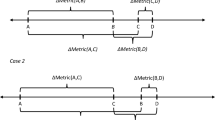Abstract
To give priority to the young over the elderly has been labelled ‘ageism’. People who express ‘ageist’ preferences may feel that, all else equal, an individual has greater right to enjoy additional life years the fewer life years he or she has already had. We shall refer to this asegalitarian ageism. They may also emphasise the greater expected duration of health benefits in young people that derives from their greater life expectancy. We may call thisutilitarian ageism. Both these forms of ageism were observed in an empirical study of social preferences in Australia. The study lends some support to the assumptions in the QALY approach that duration of benefits, and hence old age, should count in prioritising at the budget level in health care.
Similar content being viewed by others
References
Patrick, D. L., Bush, J. W. and Chen, M. M. (1973). Towards an operational definition of health.Journal of Health and Social Behaviour 14, 6–23.
Rosser, R. and Kind, P. (1978). A scale of valuations of illness: is there a social consensus?International Journal of Epidemiology 7, 347–358.
Nord, E. (1993). The trade-off between severity of illness and treatment effect in cost-value analysis of health care.Health Policy 24, 227–238.
Charny, M. C., Lewis, P. A. and Farrow, S. C. (1989). Choosing who shall not be treated in the NHS.Social Science and Medicine 28, 1331–1338.
Bråkenhielm, C. R. (1990). Vård på lika vilkår (Health care on equal terms). In,Vådens pris (The Price of Care), ed. by J. Calthorp and C. R. Bråkenhielm, Verbum forlag, Stockholm.
Bjork, S. and Rosen, P. (1993). Prioriteringar i sjukvården (Prioritising in health care).IHE arbetsrapport 1993:1, Institutet for helso- och sjukvårdse-konomi, Lund.
Busschbach, J. J. V., Hessing, D. J. and de Charro, F. T. (1993). The utility of health at different stages in life: a quantitative approach.Social Science and Medicine 37, 153–158.
Nord, E. (1993). Helsepolitikere ønsker ikke mest mulig helse per krone (Health care politicians do not wish to maximise health care benefits).Journal of the Norwegian Medical Association 11, 1371–1373.
Nord, E., Richardson, J., Street, A., Kuhse, H. and Singer, P. (1995). Maximising health benefits versus egalitarianism: an Australian survey of health issues.Social Science and Medicine 41, 1429–1437.
Harris, J. (1987). QALYfing the value of life.Journal of Medical Ethics 13,117–123
Olsen, J. A. (1994). Persons vs years: two ways of eliciting implicit weights.Health Economics 3, 39–46.
Nord, E. (1992). Methods for quality adjustment of life years.Social Science and Medicine 34, 559–569.
Nord, E. (1995). The person trade-off approach to valuing health care programs.Medical Decision Making 15, 201–208.
Clark, D. and Olsen, J. A. (1994). Agency in health care with an endogenous budget constraint.Journal of Health Economics 13, 231–251.
Schoemaker, P.J. (1982). The expected utility model: its variants, purposes, evidence and limitations.Journal of Economic Literature 20, 529–563.
Campbell, A. and Gillett, G. (1993). Justice and the right to health care. In,Ethical Issues in Defining Core Services, The National Advisory Committee on Core Health and Disability Support Services, Wellington.
Norwegian Commission for Prioritising in Health Care (1987).Retningslinjer for prioritering innen helsevesenet (Guidelines For Prioritising in Health Care). NOU 1987:23, Universitetsforlaget, Oslo.
Swedish Health Care and Medical Priorities Commission (1993).No Easy Choices—The Difficulties of Health Care. SOU 1993:93, The Ministry of Health and Social Affairs, Stockholm.
Daniels, N. (1993). Rationing fairly: programmatic considerations.Bioethics 7, 224–233.
Callahan, D. (1994). Setting mental health priorities: problems and possibilities.The Milbank Quarterly 72, 451–470.
Nord, E. (1993). The relevance of health state after treatment in prioritising between patients.Journal of Medical Ethics 19, 37–42.
Rawls, J. (1971).A Theory of Justice, Harvard University Press, Cambridge.
Essinck-Bot, M. L., Stouthard, M. E. A. and Bonsel, G. J. (1993). Generalizability of valuations on health states collected with the EuroQol questionnaire.Health Economics 2, 237–246.
Author information
Authors and Affiliations
Rights and permissions
About this article
Cite this article
Nord, E., Street, A., Richardson, J. et al. The significance of age and duration of effect in social evaluation of health care. Health Care Anal 4, 103–111 (1996). https://doi.org/10.1007/BF02251210
Issue Date:
DOI: https://doi.org/10.1007/BF02251210




